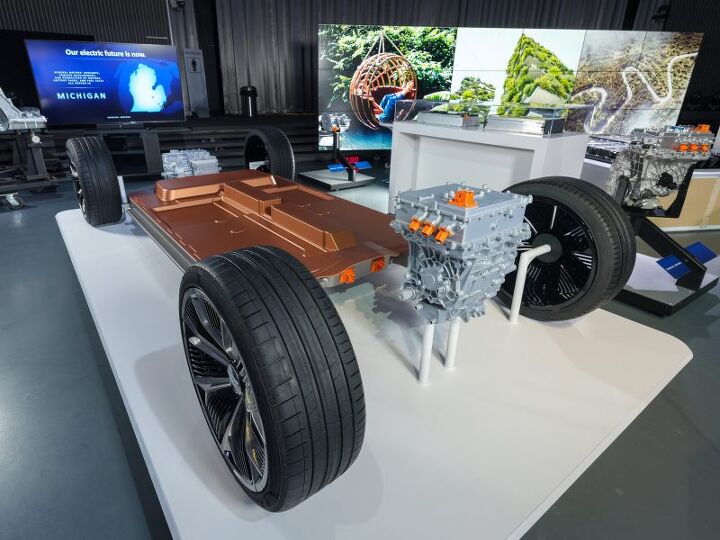Outsource to Detroit: GM Workers to Build Hondas Under EV Agreement

Sometimes, if you find yourself lagging behind the pack and eagerly wish for a quick way to catapult yourself ahead, it makes sense to piggyback on someone else’s work. And in the realm of electric vehicles — brow-furrowingly pricey and time-consuming to develop as they are — automakers are coming to the conclusion that perhaps someone else should do the heavy lifting.
Subaru has Toyota, Ford has Rivian (and Volkswagen), and Honda now has General Motors.
The two automakers announced an agreement late Thursday to partner on two jointly built electric vehicles. The two models will carry the Honda badge, but underneath will sit the modular EV platform unveiled by GM a month ago, paired with the American company’s proprietary Ultium battery technology.
Honda will design the interior and bodywork, while GM workers will assemble the things in a domestic plant. The two models’ customers will be of the North American variety. Arrival date? Sales should begin in 2024, the two said in a joint announcement.
That domestic plant could well be the sprawling Detroit-Hamtramck facility that until recently sat on GM’s chopping block, but is now designated as the automaker’s first all-EV production facility. Michigan’s Orion Township plant also assembles EVs (the Chevrolet Bolt and upcoming Bolt EUV crossover). D-Ham will receive a range of vehicles all based on the new in-house platform.
Of course, GM and Honda didn’t just meet up for the first time before dashing out to the parking lot for a round of whoopie. The two have eyed each other for years. Early last decade came a pact on hydrogen fuel cell development that birthed nothing consumer-friendly on this side of the ocean. Much more recently, in 2018, Honda sank a fair bit of cash into GM’s newly acquired Cruise self-driving arm, with the beginning of this year seeing the fruits of that collaboration. Behold, the Origin.
Honda also signed on to GM’s battery development efforts in 2018.
With Honda lagging in the electric vehicle field, sourcing a platform from GM and building a vehicle at its U.S. EV hub makes more sense than going it alone. Honda-badged EVs will be able to make it to consumers far quicker this way, and at a more attainable price.
“This collaboration will put together the strength of both companies, while combined scale and manufacturing efficiencies will ultimately provide greater value to customers,” said Rick Schostek, executive vice president of American Honda Motor Co., Inc., in a statement.
“This expanded partnership will unlock economies of scale to accelerate our electrification roadmap and advance our industry-leading efforts to reduce greenhouse gas emissions.”
Doug Parks, GM’s global product development boss, said the agreement “further validates the technical advancements and capabilities of our Ultium batteries and our all-new EV platform.”
Honda recently deep-sixed the limited-availability Clarity Electric, an EV version of its more popular PHEV model (and even scarcer hydrogen fuel cell version). That vehicle, available only as a lease to customers in California and Oregon, offered a very affordable monthly fee but could only travel 89 miles on a charge — greatly limiting its usefulness and appeal. A compliance vehicle, for sure, but also a demonstration one. Overseas, the brand stands to gain some green cred when its cute-and-retro Honda E city car goes on sale this summer, but North America remains an electric wasteland for the company, minus some new hybrid efforts.
With GM’s help, that situation will change. After all, you can’t have your main rivals driving away with all the green glory.
It’s worth noting that a platform and battery pack won’t be the only thing shared between the two auto giants. As stated by GM, “Honda will incorporate GM’s OnStar safety and security services into the two EVs, seamlessly integrating them with HondaLink. Additionally, Honda plans to make GM’s hands-free advanced driver-assist technology available.”
[Images: General Motors, Grisha Bruev/Shutterstock]

More by Steph Willems
Latest Car Reviews
Read moreLatest Product Reviews
Read moreRecent Comments
- Bd2 Lexus is just a higher trim package Toyota. ^^
- Tassos ONLY consider CIvics or Corollas, in their segment. NO DAMNED Hyundais, Kias, Nissans or esp Mitsus. Not even a Pretend-BMW Mazda. They may look cute but they SUCK.I always recommend Corollas to friends of mine who are not auto enthusiasts, even tho I never owed one, and owned a Civic Hatch 5 speed 1992 for 25 years. MANY follow my advice and are VERY happy. ALmost all are women.friends who believe they are auto enthusiasts would not listen to me anyway, and would never buy a Toyota. They are damned fools, on both counts.
- Tassos since Oct 2016 I drive a 2007 E320 Bluetec and since April 2017 also a 2008 E320 Bluetec.Now I am in my summer palace deep in the Eurozone until end October and drive the 2008.Changing the considerable oils (10 quarts synthetic) twice cost me 80 and 70 euros. Same changes in the US on the 2007 cost me $219 at the dealers and $120 at Firestone.Changing the air filter cost 30 Euros, with labor, and there are two such filters (engine and cabin), and changing the fuel filter only 50 euros, while in the US they asked for... $400. You can safely bet I declined and told them what to do with their gold-plated filter. And when I changed it in Europe, I looked at the old one and it was clean as a whistle.A set of Continentals tires, installed etc, 300 EurosI can't remember anything else for the 2008. For the 2007, a brand new set of manual rec'd tires at Discount Tire with free rotations for life used up the $500 allowance the dealer gave me when I bought it (tires only had 5000 miles left on them then)So, as you can see, I spent less than even if I owned a Lexus instead, and probably less than all these poor devils here that brag about their alleged low cost Datsun-Mitsus and Hyundai-Kias.And that's THETRUTHABOUTCARS. My Cars,
- NJRide These are the Q1 Luxury division salesAudi 44,226Acura 30,373BMW 84,475Genesis 14,777Mercedes 66,000Lexus 78,471Infiniti 13,904Volvo 30,000*Tesla (maybe not luxury but relevant): 125,000?Lincoln 24,894Cadillac 35,451So Cadillac is now stuck as a second-tier player with names like Volvo. Even German 3rd wheel Audi is outselling them. Where to gain sales?Surprisingly a decline of Tesla could boost Cadillac EVs. Tesla sort of is now in the old Buick-Mercury upper middle of the market. If lets say the market stays the same, but another 15-20% leave Tesla I could see some going for a Caddy EV or hybrid, but is the division ready to meet them?In terms of the mainstream luxury brands, Lexus is probably a better benchmark than BMW. Lexus is basically doing a modern interpretation of what Cadillac/upscale Olds/Buick used to completely dominate. But Lexus' only downfall is the lack of emotion, something Cadillac at least used to be good at. The Escalade still has far more styling and brand ID than most of Lexus. So match Lexus' quality but out-do them on comfort and styling. Yes a lot of Lexus buyers may be Toyota or import loyal but there are a lot who are former GM buyers who would "come home" for a better product.In fact, that by and large is the Big 3's problem. In the 80s and 90s they would try to win back "import intenders" and this at least slowed the market share erosion. I feel like around 2000 they gave this up and resorted to a ton of gimmicks before the bankruptcies. So they have dropped from 66% to 37% of the market in a quarter century. Sure they have scaled down their presence and for the last 14 years preserved profit. But in the largest, most prosperous market in the world they are not leading. I mean who would think the Koreans could take almost 10% of the market? But they did because they built and structured products people wanted. (I also think the excess reliance on overseas assembly by the Big 3 hurts them vs more import brands building in US). But the domestics should really be at 60% of their home market and the fact that they are not speaks volumes. Cadillac should not be losing 2-1 to Lexus and BMW.
- Tassos Not my favorite Eldorados. Too much cowbell (fins), the gauges look poor for such an expensive car, the interior has too many shiny bits but does not scream "flagship luxury", and the white on red leather or whatever is rather loud for this car, while it might work in a Corvette. But do not despair, a couple more years and the exterior designs (at least) will sober up, the cowbells will be more discreet and the long, low and wide 60s designs are not far away. If only the interiors would be fit for the price point, and especially a few acres of real wood that also looked real.




































Comments
Join the conversation
"......while GM workers will assemble the things in a domestic plant....". Now what could go wrong with that?
Riding lawn mowers are built this way, it was only a matter of time before the auto companies realized they too can’t afford brand-specific manufacturing.